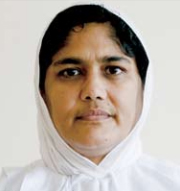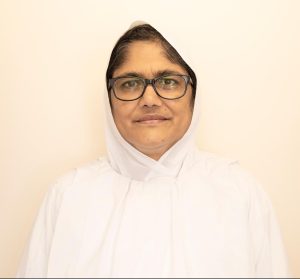
Centre of Jaina Studies Newsletter: SOAS - University of London
My doctoral research at SOAS focuses on prekṣādhyāna, or perceptual meditation, a modern system of meditation introduced in 1975 by Ācārya Mahāprajña (1920-2010) of the Jaina Śvetāmbara Terāpantha tradition, as the culmination of a long period of research and spiritual practice.[1] In the modern period, prekṣā meditation becomes a means of purification rather than liberation. Mahāprajña explains the word prekṣā-dhyāna as follows:
The word prekṣā is derived from the Sanskrit root √ikṣa, which means "to see". When the prefix "pra" is added, it becomes pra+ ikṣa=prekṣā, which means "to perceive carefully and profoundly". Here 'seeing' does not mean external vision, but careful concentration on subtle consciousness by mental insight. Prekṣā dhyāna is the system of meditation engaging one's mind fully in the perception of subtle internal and innate phenomena of consciousness (italics added).[2]
The term 'insight meditation' echoes Buddhist vipassanā meditation. But the method is entirely different. It means perceive and realise the subtle aspects of self through the self. Prekṣā meditation is a seven-fold method of meditation that is presented by Mahāprajña as follows:[3]
- Kāyotsarga: Relaxation with self-awareness.
- Antarayātrā: Internal journey.
- Śvāsa-Prekṣā: Perception of breathing.
- Śarīra-Prekṣā: Perception of the body.
- Caitanya-Kendra-Prekṣā: Perception of psychic centre.
- Leṣyā-dhyāna: Perception of the psychic colours.
- Anuprekṣā: Contemplation
I will investigate how and why this modern system of Jaina meditation came into existence. There have been a number of comparative, therapy-oriented and sociocultural studies of prekṣā meditation, but a comprehensive study of the historical development and methods of prekṣā-dhyāna has not yet been carried out. It is one of the aims of this study to address this gap in academic research.
In the classical and medieval periods early Jaina meditation underwent a shift in terms of classification and form. As a result of influences from classical Hindu systems of meditation, incorporating yoga and tantra, Jaina meditation theory and practice was radically re-shaped. I contend that classical Jaina meditational theory and practice then underwent a second radical transformation in the modern period as a consequence of its encounter with modern Buddhist systems of meditation, and more broadly with modernity, in particular, its fusion with modern scientific and medical discourses.

Samani Pratibha Pragya
My hypothesis is that the encounter of early ascetic and medieval ritualistic forms of Jaina meditation with modern natural science resulted in the development of prekṣā meditation, which represents a new synthesis of ancient and modern elements. I will show that early Jaina literature does not describe the same type of meditative practices which were developed by Ācārya Mahāprajña in the modern period, and that classical and early modern accounts of Jaina meditative practice are, similarly, quite different from Mahāprajña's prekṣā meditation. I will investigate relevant textual sources to provide a historical overview of early forms of Jaina meditation which form a substratum for modern forms of meditation. The thesis will be based on a combination of different methodologies. A text-historical study of key sections of the Jaina canon and its commentaries will be undertaken with a view to ascertaining Jaina approaches to meditation that prevailed from the early to the classical period.
An analysis of exegetical methods will be made with regard to the uses of primary resources by the propounder of modern prekṣā-dhyāna, assuming that commentary is a means in the process of tradition-building. Without understanding commentarial literature, the past cannot be connected with present. In this study, a range of texthistorical exegetical approaches will therefore be used, in particular, in relation to Sanskrit and Prakrit texts. Historical methods will be employed in order to trace the processes of construction of prekṣā meditation, including practical experiments on the basis of biographical and autobiographical accounts of Ācārya Tulsī (1914-1997) and Ācārya Mahāprajña (19202010), as well as interviews with core participants in the historical development of prekṣā meditation, and archival materials in India.
The construction of prekṣā meditation as an explicitly modern form of practice will be studied in the light of the theory of 'Jaina Modernism'. The term was coined by Peter Flügel in 1994, 'as a distinct type of Jainism with unique characteristics', in which scientific analysis of Jaina texts and practices is a path towards modernity.[4]
The introduction will explain the purpose of the thesis include a literature review, and an outline of the sources and methodology used in this study.
Chapter two begins with an analysis of early textual accounts of the meditative practices of Mahāvīra. It then provides an overview of the practices of meditation attested in Jaina canonical, classical, medieval and premodern texts and examines the Buddhist and Hindu influences on Jaina meditation. The purpose of the chapter is to prepare the ground for the subsequent determination of the differentia specifica between pre-modern forms of Jaina meditation and modern forms of meditation such as prekṣā meditation. The chapter focuses on a discussion of the development of the Prakrit term jhāṇa, (Skt. dhyāna); which first appeared in the early canonical period and was later defined in terms of more elaborate classifications of meditation. The medieval and pre-modern periods produced a number of specific treaties on meditation, which were influenced by the Hindu and the Buddhist tradition.
The material provided for chapter two is a contribution to the exploration of the pre-modern historical background of Jaina meditative practices in the early to late canonical period, and in the classical and medieval periods. How these practices became a substratum for the modern system of meditation will be examined in chapters three and four of the thesis.
In chapter three, I will postulate what Ācārya Tulsī's motivation was for creating a distinct system of Jaina meditation and how prekṣā meditation was developed historically by Mahāprajña. In addition, what role did their meditational experiences play in the construction of prekṣā meditation? This chapter also discusses briefly the intellectual development within the Terāpanth sect and its institutional and ideological growth at the turn of late nineteenth to twentieth century. I will use the voluminous work on the history of Terāpanth by Muni Budhamala,[5] and a series of the histories of ascetics of the Terāpantha compiled in twenty-five parts by Muni Navaratnamala (1981ff.) called 'Śāsana Samudra' to examine meditational practices over two hundred and fifty years, particularly Jayācārya's two compositions 'choṭo dhyāna' and 'baḍo dhyāna' along with a small 'dhyāna vidhi' on meditation. I will examine in particular, Tulsī's (1960) work Manonuśāsanam, composed in Sanskrit sūtras, and its commentary in Hindi by Mahāprajña, which is known as a foundation book of prekṣā meditation. It will be useful to explore whether any early meditative practices were prevalent and if there were any aspects through which prekṣā meditation evolved. Interviews and archival research will be conducted during fieldwork.
I will examine how the historical development of prekṣā-dhyāna as a modern system of meditation has sought to combine scriptural knowledge, imports from other traditions of yoga and meditation, modern science and subjective meditative experiences, in order to cause modern psychological and social objectives such as behavioural modification and personality development, or health and well-being, along with traditional soteriological goals of self-purification and self-realization. I argue that its roots, however, are derived from Jaina canonical literature which describes the meditative practices of Mahāvīra himself.
In chapter four, I will examine the building blocks of prekṣā meditation. Mahāprajña provides three accounts for the process of construction of prekṣā meditation: (i) canonical, classical and medieval textual accounts of meditative practices; (ii) integration of Buddhist and Hindu yoga systems and science; (iii) his own experiences and research carried out with a team of monks, nuns, lay followers and Jain Vishva Bharati University faculty and students. I will focus on the formulation of the methods of prekṣā and its development in four distinct domains: as 'meditation' (prekṣā-dhyāna), as 'yoga' (prekṣā-yoga) as 'therapy' (prekṣā-cikitsā) and recently as developed 'skill' (prekṣā-kauśala). A study of Buddhist and Hindu influences on prekṣā meditation will also be discussed in subsequent chapters three and four.
In chapter four, a key question concerns the exegetical methods of Ācārya Mahāprajña and his integration of elements from different sources and traditions to form a new synthesis. How, for instance, he incorporated Buddhist meditation and Hindu forms of yoga into prekṣā meditation will be assessed, as will his idea of 'prekṣā-yoga', containing seven limbs and a variety of 'sub-limbs'. Furthermore, he developed 'prekṣā therapy' as a means of achieving better health and for curing various physical and mental ailments and recently added prekṣā skill (prekṣā-kauśala) for youth to develop their personality.
These important topics will be equally explored in relation to the development of the prekṣā system over a four-decade period. Finally, in chapter five, I will look at other forms of modern Jaina meditation, given that there are a number of other Jaina sects which have developed various forms of meditation. Taken as a whole, then, this is a study of the recent past and of the present of the living tradition of Jainism, studied in relation to its connections to the wider indigenous roots of meditation and yoga, stretching in the case of Jainism to the time of its formation in ancient India.
See: P. Flügel, Das rituelle System der Terāpanth Śvetāmbara Jains. PhD dissertation University of Mainz, 1994 (Available: Centre of Jaina Studies Working Papers Vol. 1, 2012: http://eprints.soas.ac.uk/14492/), and 'Jaina Modernism', Jaina Studies Newsletter of the CoJS Vol. 2, 2007, p. 6.
 Dr. Samani Pratibha Pragya
Dr. Samani Pratibha Pragya